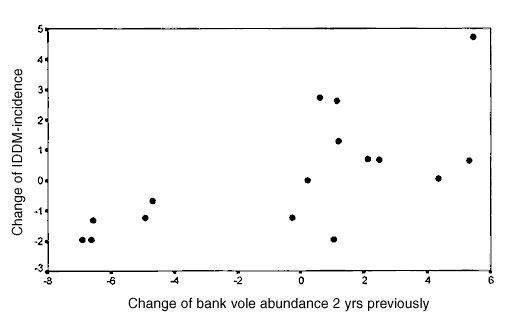Volume 4, Number 2—June 1998
Perspective
Could Myocarditis, Insulin-Dependent Diabetes Mellitus, and Guillain-Barré Syndrome Be Caused by One or More Infectious Agents Carried by Rodents?
Figure 11

Figure 11. Change of insulin-dependent diabetes mellitus incidence, 1975–1991, relative to change of bank vole abundance 2 years previously, after transformation of time series by differencing (1) (vole data from 1973-1989). r = 0.595, n = 16.
References
- Niklasson B, Le Duc J. Epidemiology of nephropathia epidemica in Sweden. J Infect Dis. 1987;155:269–76.PubMedGoogle Scholar
- Hansson L, Henttonen H. Gradients in density variations of small rodents: the importance of latitude and snow cover. Oecologia. 1985;67:394–402. DOIGoogle Scholar
- Hansson L, Henttonen H. Rodent dynamics as community processes. Trends Ecol Evol. 1988;3:195–200. DOIGoogle Scholar
- Hörnfeldt B. Delayed density dependence as a determinant of vole cycles. Ecology. 1994;75:791–806. DOIGoogle Scholar
- Niklasson B, Hörnfeldt B, Lundkvist Å, Björsten S, LeDuc J. Temporal dynamics of Puumala virus antibody prevalence in voles and of nephropathia epidemica incidence in humans. Am J Trop Med Hyg. 1995;53:134–40.PubMedGoogle Scholar
- Hörnfeldt B. Smådäggdjursinventering i PMK:s referensområden - rapport från verksamheten 1992. Solna, Sweden: Swedish Environmental Protection Agency; 1994. Report 4294.
- Lindström ER, Andrén H, Angelstam P, Cederlund G, Hörnfeldt B, Jäderberg L, Disease reveals the predator: sarcoptic mange, red fox predation and prey populations. Ecology. 1994;75:1042–9. DOIGoogle Scholar
- Lindström ER, Hörnfeldt B. Vole cycles, snow depth and fox predation. Oikos. 1994;70:156–60. DOIGoogle Scholar
- Jiang GX, de Pedro-Cuesta J, Fredriksson G. Guillain-Barré syndrome in South-West Stockholm, 1973-1991. Quality of registered hospital diagnosis and incidence. Acta Neurol Scand. 1995;91:109–17.PubMedGoogle Scholar
- Winner SJ, Evans JG. Age-specific incidence of Guillain-Barré syndrome in Oxfordshire. Quarterly Journal of Medicine. New Series. 1990;77:1297–304.
- Box GEP, Jenkins GM. Time series analysis, forecasting and control. San Francisco: Holden Day; 1970.
- SPSS Base System Syntax Reference Guide. Release 6.0. Carey (NC): SPSS Inc.; 1993.
- Myhrman G. En njursjukdom med egenartad symptombild. [In Swedish]. Nord Med Tidskr. 1934;7:793–4.
- Gajdusek DC. Virus haemorrhagic fevers-special reference to haemorrhagic fevers with renal syndrome (epidemic haemorrhagic fever). J Pediatr. 1962;60:841–57. DOIPubMedGoogle Scholar
- Wesslén L, Påhlson C, Friman G, Fohlman J, Lindquist O, Johansson C. Myocarditis caused by Chlamydia pneumonie (TWAR) and sudden unexpected death in a Swedish elite orienteer. Lancet. 1992;340:427–8. DOIPubMedGoogle Scholar
- Hörnfeldt B. Synchronous population fluctuations in voles, small game, owls and tularemia in northern Sweden. Oecologia. 1978;32:141–52. DOIGoogle Scholar
- Hörnfeldt B, Löfgren O, Carlsson B-G. Cycles in voles and small game in relation to variations in plant production indices in northern Sweden. Oecologia. 1986;68:496–502. DOIGoogle Scholar
Page created: December 14, 2010
Page updated: December 14, 2010
Page reviewed: December 14, 2010
The conclusions, findings, and opinions expressed by authors contributing to this journal do not necessarily reflect the official position of the U.S. Department of Health and Human Services, the Public Health Service, the Centers for Disease Control and Prevention, or the authors' affiliated institutions. Use of trade names is for identification only and does not imply endorsement by any of the groups named above.